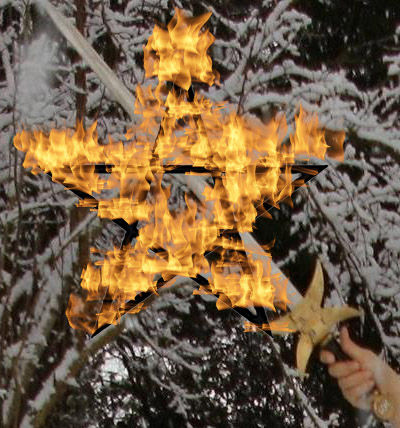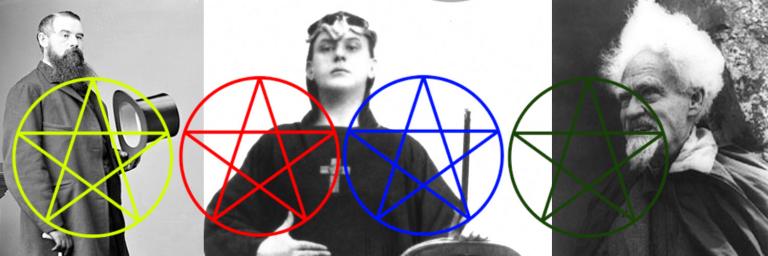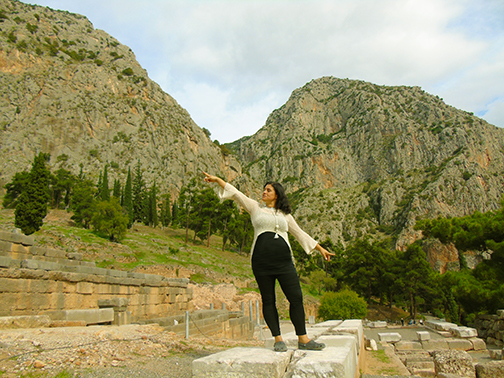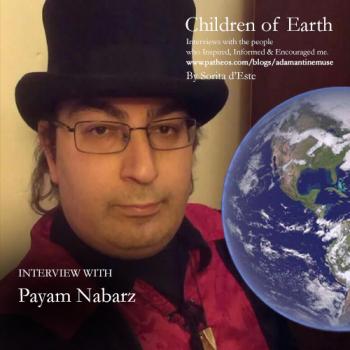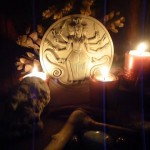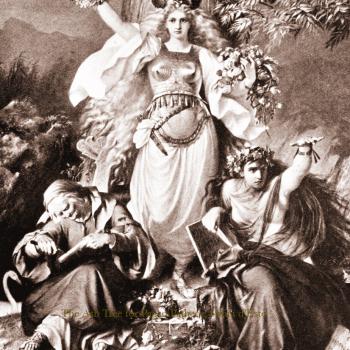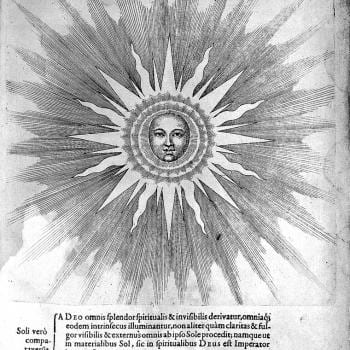This week I kept bumping into various articles on Wicca, and in particular the Charge of the Goddess, in rather unexpected ways. I love the text of the Charge, but I have a personal annoyance with the way it is attributed to Doreen Valiente. The fact is, even though it is sometimes heretical to say so, Doreen Valiente did not write the Charge of the Goddess.
This is also not a revelation, because Doreen herself in her book The Rebirth of Witchcraft (1987) claimed that she edited the earlier Lift up the Veil Charge she encountered in Gerald Gardner’s Book of Shadows to remove a section which was taken directly from Aleister Crowley’s Gnostic Mass. By comparing the two versions, both of which have been in the public domain for many years, it is evident that the second half of the Charge of the Goddess is indeed significantly different from the earlier Lift up the Veil version.
But there is another curious anomaly with Doreen’s story. In The Rebirth of Witchcraft Doreen wrote that she rewrote the Charge “cutting out the Crowleyanity as much as I could”. Which is a strange claim considering that so much of the earlier material by Crowley, which she removed, was replaced by more work by Crowley – but there might be an explanation.
This analysis, which is adapted from the more detailed analysis in the 2008 book Wicca: Magical Beginnings, which I co-authored with David Rankine, illustrates just how much of the Charge comes directly from, or has been directly influenced by earlier work.
 Textual Analysis: The Charge of the Goddess
Textual Analysis: The Charge of the Goddess
(Much of this was published in 2005, 2008 in WMB)
The Charge commences with:
“Whenever ye have need of anything, once in the month, and better it be when the Moon is full. Then ye shall assemble in some secret place and adore the spirit of Me who am Queen of all Witcheries. There ye shall assemble, ye who are fain to learn all sorcery, yet who have not won its deepest secrets. To these will I teach things that are yet unknown. And ye shall be free from slavery, and as a sign that ye be really free, ye shall be naked in your rites…”
This is nearly verbatim from the 1899 book by Charles G. Leland, Aradia: Gospel of the Witches:
“Whenever ye have need of anything, once in the month, and when the Moon is full, ye shall assemble in some desert place, or in a forest all together join to adore the potent spirit of your queen, My mother, great Diana. She who fain would learn all sorcery yet has not won its deepest secrets, them my mother will teach her, in truth all things as yet unknown. And ye shall all be freed from slavery, and so ye shall be free in everything; and as the sign that ye are truly free, ye shall be naked in your rites, both men and women also.”
The Charge then continues:
“…and ye shall dance, sing, feast, make music, and love, all in my praise.”
Which again comes from Leland’s Aradia, adapted from the following:
“… and, the feast over, they shall dance, sing, make music, and then love in the darkness, with all the lights extinguished: for it is the Spirit of Diana who extinguishes them, and so they will dance and make music in her praise.”
It continues:
“For mine is the ecstasy of the Spirit, and mine is also joy on earth.
For my Law is Love unto all beings.”
This is where it starts getting strange, as the above appears to be cobbled together from Aleister Crowley’s Law of Liberty, quoting “ecstasy be thine and joy of earth” (AL I.53) and “love is the law” (AL I.57). Followed by more Crowley:
“Keep pure your highest ideal. Strive ever towards it. Let naught stop you or turn you aside. “
This time taken from Crowley’s Law of Liberty, where he wrote: “Keep pure your highest ideal; strive ever toward it, without allowing aught to stop you or turn you aside.” This key line refers to the concept of the true will, and doing only what is right to achieve your full potential.
The Charge continues:
“For mine is the secret door which opens upon the land of youth;”
This is rewritten from the earlier version of the Charge (Lift Up the Veil), which draws more directly from Liber Al, “There is a secret door that I shall make to establish thy way in all the quarters” (AL III.38).
And then:
“and mine is the cup of the Wine of Life: “
Finally, something which might be original to the Charge; though it is interesting to note that the same phrase “The Cup of the Wine of Life” occurs in the Roman Catholic liturgy …
“and the Cauldron of Ceridwen, which is the Holy Grail of Immortality.”
And again this might be original, though again the concept of the Holy Grail of Immortality is of course also a Christian one, with the Holy Grail being like the Cauldron of Ceridwen.
The Charge continues:
“I am the Gracious Goddess who gives the gift of
Joy unto the heart of Man.
Upon Earth I give the knowledge of the Spirit Eternal,
and beyond death I give peace and freedom,
and reunion with those who have gone before.
Nor do I demand aught in sacrifice, “
This is another extract from the Law of Liberty, derived from Liber AL 1.58 adapted and expanded on from Crowley’s original: “For hear, how gracious is the Goddess; “I give unimaginable joys on earth: certainty, not faith, while in life, upon death; peace unutterable, rest, ecstasy; nor do I demand aught in sacrifice.”
“…for behold, I am the Mother of all things,
and my love is poured out upon the earth.”
This may have been inspired, at least in part, by the writings of John Milton (9 December 1608 – 8 November 1674); or by Qabalistic philosophy.

“ Hear ye the words of the Star Goddess,“
Once again the text returns to Crowley’s Law of Liberty, “We have heard the voice of the Star Goddess”, emphasising the Egyptian stellar goddess Nuit, who represents the entire universe in the cosmology of Thelema.
“She in the dust of whose feet are the hosts of Heaven, whose body encircleth the universe.”
This could be original, most likely inspired by Crowley’s love of the Egyptian Star Goddess Nuit, whose body is the night sky encircling us.
“ I who am the beauty of the green earth;
and the White Moon amongst the Stars; and the mystery of the Waters;
and the desire of the heart of man,”
The above is mostly, probably, original material, though it is possible the line “desire of the heart of man,” may have been inspired by Crowley’s book The Vision and the Voice (1909) where we find “I am the blind ache within the heart of man”. We may note however that the phrase “beauty of the green earth” used in conjunction with stellar references was a common occurrence in Christian writings of the nineteenth and early twentieth century, so this is a well-documented analogy. Illustrating this point with two examples, in The British Preacher (1831) we read “How good must that light be which reveals to us the grandeur of the starry heavens, and the beauty of the green earth,” and in Evangelical Christendom (1893) we see, “if the glories of the starry heavens, if the beauty of the green earth never taught man of God”.
“call unto thy soul: arise and come unto me. “
This is again derived from Crowley’s work, as “arouse the coiled splendour within you: come unto me!” is found in both the Law of Liberty and its inspiration Liber AL I.61.
“For I am the Soul of nature who giveth life to the Universe;
From me all things proceed; and unto me, all things must return.”
This is probably inspired by the Ritual for Transformation of the Hermetic Order of the Golden Dawn, in which we find “O Soul of Nature giving life and energy to the Universe. From thee all things do proceed. Unto Thee all must return.” Alternatively, it is possible that the author of the Charge took the line, “From me all things proceed; and unto me, all things must return”, directly from Milton’s Paradise Lost, which was the probable source of inspiration for the Golden Dawn.
“and before my face, Beloved of the Gods and men,”
Probably original material, well kind of. In Norse myths, Baldur, the son of Odin is eferred to as “beloved of Gods and men” which might have provided some inspiration for the use of the term; however, this seems strange and unlikely considering he is male. With these being words of the goddess this would be an inappropriate usage. However, the Greek goddess of love, Aphrodite, was also sometimes referred to by the same title, and it is hopefully more likely that the author(s) of the Charge, may have taken their inspiration from this goddess rather than using the title of a male god.
As a curious aside – and almost certainly just coincidental, it is amusing to mention that this line is also found in Mary Ware: The Little Colonel’s Chum, Johnston a novel published in 1908 which has a character called Doreen in!
“let thine inmost divine self shall be enfolded in the raptures of the infinite.”
Again this seems to be derived from two more quotes merged from the Law of Liberty: “He is then your inmost divine self” and “in the constant rapture of the embraces of Infinite Beauty”. These quotes are words attributed to Hadit, the masculine divine (i.e. the God) in the cosmology of Aleister Crowley’s Thelema. Being used in a Charge for the Goddess is inappropriate, and may indicate that the person compiling this version of the Charge was not familiar with Crowley’s work or philosophy. Rather they thought of the words as mere poetry to be used, as it would seem from this that the material used to compile the Charge was used regardless of its original context and symbolism.
Valiente’s remark in An ABC of Witchcraft that Gardner told her he “had supplied words which seemed to him to convey the right atmosphere, to strike the right chords in one’s mind” might explain a few things here. If Gardner gave Valiente a few quotes to work with, then she may simply not have been aware of the authorship of the material she was weaving together to create her adaptation of the Charge; and so she would not have known that she was replacing Crowley with more Crowley quite so often!
“Let my worship be within the heart that rejoiceth, for behold:”
The line “heart that rejoiceth” could be taken from Crowley’s Vision and the Voice, though it is not a unique phrase so this may be a coincidence.
“all acts of love and pleasure are my rituals; “
More from the Law of Liberty, here emphasising the sexual and sensual components of magical ceremony in a very Crowleyan manner, “Remember that all acts of love and pleasure are rituals”
“and therefore let there be Beauty and Strength,
Power and Compassion,
Honour and Humility, Mirth and reverence within you.”
The reference to “beauty and strength” could be from Liber Al (AL II.20) or may be a coincidence. The rest all seems to be original, though it may have been inspired by “let there be Harmony and Beauty in your mystic loves, that in us may be health and wealth and strength and divine pleasure according to the Law of Liberty”; words spoken by the Deacon during the Gnostic Mass, another of Crowley’s works.
“And thou who thinkest to seek me, know that thy seeking and yearning shall avail thee not unless thou know the mystery,
that if that which thou seekest thou findest not within thee,
thou wilt never find it without thee, for behold;
I have been with thee from the beginning,
and I am that which is attained at the end of desire.”
The inspiration here comes from Crowley’s Liber LXV, lines 59-60, “But I have called unto Thee, and I have journeyed unto Thee, and it availed me not. I waited patiently, and Thou wast with me from the beginning.”

When examining the above, it is essential to remember that the Charge was initially compiled for use in private, oath-bound ceremonies. None of those who were involved in compiling it could have guessed that some 70 or 80 years later people would be taking an interest in it. It is also obvious from Doreen Valiente and Gerald Gardner’s writings that they did not claim authorship of the material we are now so readily attributing to them. Doreen said that she rewrote the Charge, not that she wrote it from scratch. She wanted to remove the Crowleyanity, but most likely did not recognise that the material Gardner gave her to work contained lesser known quotes by the same author!
So why am I sharing this with you here?
I feel that it is important to share information. Furthermore, I think that it is imperative for us to celebrate and acknowledge the sources of the texts and philosophies we perpetuate and hold sacred. By knowing the origins, we can root ourselves in the context and gain a deeper understanding of our rituals, magic and devotion to the Gods.
Doreen may have edited the Charge, she may have recompiled it into its best-known form, but the words were those of others who came before her.
Further reading:
Wicca: Magickal Beginnings by d’Este & Rankine, 2008
The Charge of the Goddess: A History by Jason Mankey – https://www.patheos.com/blogs/panmankey/2015/04/the-charge-of-the-goddess-a-history/
Bibliography:
Crowley, Aleister, 777 & Other Qabalistic Writings of Aleister Crowley, 1983 (first published in 1909), Samuel Weiser Inc., Maine
———–, Moonchild, 1929, The Mandrake Press, London
———–, Crowley on Christ (first published in 1916 as The Gospel According to Saint Bernard Shaw), 1974, C.W. Daniel, London
———–, The Book of the Goetia of Solomon the King, 1996 (first published in 1904), Red Wheel/Weiser, Maine
———–, Liber AL vel Legis (The Book of the Law), 1938 (first received in 1904), O.T.O., London
———–, Magick in Theory and Practice, 1929, Lecram, Paris
———–, The Revival of Magic & other Essays, 1998 (first published in 1917), New Falcon, Arizona
———–, Rodin in Rime, 1907, privately printed, London
———–, The Equinox Volume 3 No. 1 (The Blue Equinox), 1971 (first published in 1919), Samuel Weiser, Maine
———–, Liber Agapé & De Arte Magica, 1986 (first published in 1914), Kadath Press, Keighley
———-, The Vision and the Voice, 1972 (first published in 1909 in The Equinox Vol 1 No 5), Sangreal Foundation, Texas
Gardner, Gerald, A Goddess Arrives, 2000 (first published in 1939), I-H-O Books, Thame
———–, High Magic’s Aid, 1999 (first published in 1949), I-H-O Books, Thame
———–, The Meaning of Witchcraft, 2000 (first published in 1959), I-H-O Books, Thame
———–, Witchcraft Today, 1954, Rider & Co., London
Leland, C.G., Aradia: Gospel of the Witches, 1899, David Nutt, London
———–, Etruscan Roman Remains in Popular Tradition, 1892, T. Fisher Unwin, London
———–, Gypsy Sorcery, 1993 (first published in 1889), Anthony Naylor & Dwina Murphy-Gibb, Thame
———–, Legends of Florence, 1896, David Nutt, London.
Valiente, Doreen, An ABC of Witchcraft Past and Present, 1973, Robert Hale Ltd, London
———–, Witchcraft Today, 1978, Robert Hale Ltd, London
———–, The Rebirth of Witchcraft, 1987, Robert Hale Ltd, London
Various, The Westminster Review, 1824, Baldwin, Cradock & Joy, London
Various, Time’s Telescope for 1826; or A Complete Guide to the Almanack, 1826, Sherwood, Gilbert, and Piper, London
Various, The British Preacher, 1831, Frederick Westley and A.H. David, London
Various, The New monthly belle assemblée, 1838, Joseph Rogerson, London
Various, The ladies’ cabinet of fashion, music & romance, 1839, G Henderson, London
Various, The Freemason’s Quarterly Magazine and Review, 1846, London
Various, The London Spectator, April 22nd 1895, London
